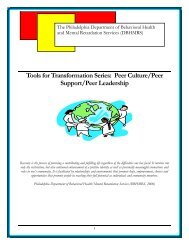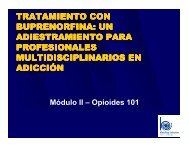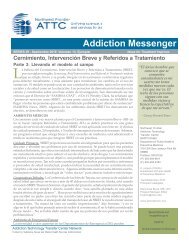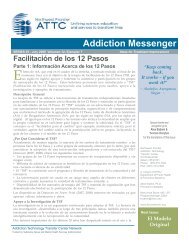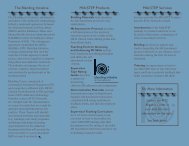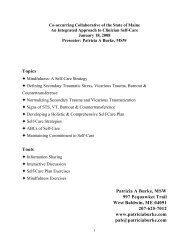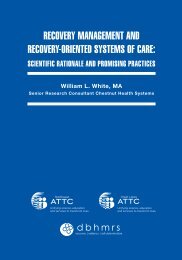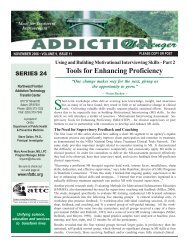alcohol and other drug problems among addiction professionals
alcohol and other drug problems among addiction professionals
alcohol and other drug problems among addiction professionals
Create successful ePaper yourself
Turn your PDF publications into a flip-book with our unique Google optimized e-Paper software.
nSupport for PoliciesAs many participants noted, a policy manual sitting on a shelf has only limitedpower. To be effective, policies on emotional <strong>and</strong> behavioral health issues must receivesupport from all organizational levels.Whenever possible, staff interactions should be guided by effective, science-basedcommunication, problem-resolution, <strong>and</strong> team-building processes.Employees should receive notification of <strong>and</strong> training in these <strong>and</strong> <strong>other</strong> areas beforebeing held accountable for them. Effective supervision is also essential to theeffective application of policies <strong>and</strong> procedures.These issues are best addressed within the context of general individual <strong>and</strong>organizational wellness. The agency needs an integrated process for employee selection,orientation, on-the-job training, stress management, supervision, employeefeedback, formal st<strong>and</strong>ards for probationary status, <strong>and</strong> corrective discipline. All ofthese elements should be tied to employee wellness, team functioning, <strong>and</strong> employeeassistance programs. Management of AOD issues must be integrated withmanagement in general, <strong>and</strong> with the management of employees who experience<strong>problems</strong> that affect their job performance or team participation.Of primary importance is the establishment <strong>and</strong> organization-wide support ofhigher st<strong>and</strong>ards for therapy staff, whether or not those staff members are in recovery.This high st<strong>and</strong>ard of sober <strong>and</strong> responsible behavior must be applied consistently tocommunication with <strong>other</strong> staff, conflict resolution, relationships with clients, managementof routine client care, <strong>and</strong> the resolution of client-management issues.Both recovering <strong>and</strong> non-recovering staff should be expected to create <strong>and</strong>maintain an AOD-free workplace; model clear-minded, sober, responsible, courteous,<strong>and</strong> professional conduct; <strong>and</strong> foster effective <strong>and</strong> trustworthy relationshipswith colleagues <strong>and</strong> clients. These should be considered the minimum requirementsof therapeutic staff. If employers <strong>and</strong> the field as a whole focus, not on recovery status,but on the st<strong>and</strong>ards to which <strong>addiction</strong> <strong>professionals</strong> must be held, all <strong>other</strong>issues will gain clarity <strong>and</strong> perspective.nPromoting Employee WellnessIn a field whose dem<strong>and</strong>s are often not conducive to self-care, the needs ofrecovering staff provide a legitimate challenge to the prevailing “do more <strong>and</strong> morewith less <strong>and</strong> less” approach toward meeting those dem<strong>and</strong>s. In many cases, theultimate consequence of neglect of self-care would be a relapse to active <strong>addiction</strong>.However, wellness can be a difficult commodity to assess <strong>and</strong> address. Giventhat organizational wellness is also an essential component in supporting individualwellness-<strong>and</strong> often a difficult one to achieve-organizational leaders are also responsiblefor addressing organizational wellness issues in effective ways.n 42 n





